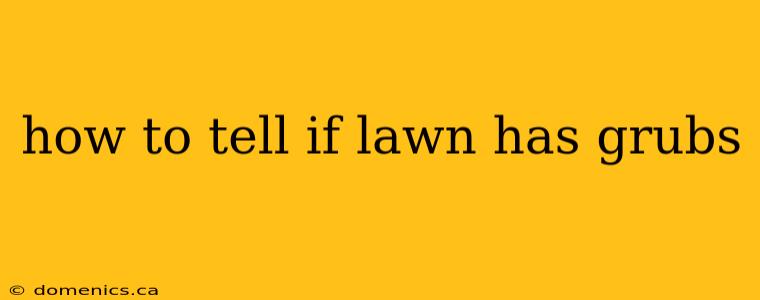Grubs, the larvae of June beetles, Japanese beetles, and other insects, can wreak havoc on your lawn. They feed on grass roots, leaving behind brown patches and making your lawn susceptible to disease and damage. Knowing how to spot grub infestations early is key to protecting your yard. This guide will teach you how to tell if your lawn has grubs and what steps to take next.
Signs of a Grub Infestation
Several clues indicate a potential grub problem. Don't rely on just one sign; several together confirm a larger issue.
1. Brown Patches and Dying Grass
One of the most visible signs is the appearance of brown, patchy areas in your lawn. These patches may be irregular in shape and size, and the grass within them will be easy to pull up, revealing the damaged roots. The grass may also feel unusually spongy or loose underfoot.
2. Birds and Other Animals
Increased bird activity in your lawn, especially noticeable in the fall, can be a strong indicator of grubs. Birds are opportunistic feeders; if they're digging in your lawn, they're likely after a tasty grub meal. Skunks and raccoons are also culprits, often creating extensive areas of digging.
3. Inspecting Your Lawn for Grubs
The most definitive way to know if you have grubs is by performing a physical inspection. This involves a simple test:
How to Perform a Grub Test
- Choose a Representative Area: Select a few areas of your lawn exhibiting the symptoms mentioned above.
- Square Footage: Dig up a square foot of sod in each area.
- Count the Grubs: Carefully examine the soil and count the number of grubs you find.
- Threshold: A healthy lawn should have fewer than 5 grubs per square foot. More than that, and you likely have an infestation that requires treatment.
4. Lawn That Feels Spongy
Walk across your lawn. Does it feel unusually soft or spongy? Grubs feeding on the roots loosen the soil, creating this effect. This is especially noticeable in drier conditions.
Types of Grubs that Damage Lawns
Several types of grubs can damage your lawn. Identifying the type isn't always necessary for treatment, but it can help you choose the best approach. Common culprits include:
- Japanese Beetle Grubs: These are C-shaped, creamy white grubs with brown heads.
- June Beetle Grubs: Similar in appearance to Japanese beetle grubs but slightly larger.
- White Grubs (Various Species): A broad category encompassing several different species of grubs that can damage lawns.
What to Do If You Find Grubs
If your grub count exceeds the healthy threshold (more than 5 per square foot), it's time to take action. Here are a few options:
- Natural Predators: Encourage natural predators like birds and beneficial nematodes.
- Chemical Treatments: Several insecticides are available to control grub populations. Always follow the product instructions carefully. Consider environmentally friendly options when possible. Consult your local garden center or agricultural extension office for advice on effective and safe treatments.
- Cultural Practices: Improving soil health and lawn care can help prevent future infestations. This includes proper fertilization, watering, and aeration.
Preventing Future Grub Infestations
Prevention is key when it comes to grubs. Here are some tips:
- Healthy Lawn: Maintain a healthy lawn through proper fertilization, watering, and aeration. A strong lawn is more resilient to grub damage.
- Beneficial Nematodes: Introduce beneficial nematodes to your soil. These microscopic worms feed on grubs.
- Proper Watering: Avoid overwatering, as this can create favorable conditions for grub development.
- Regular Inspections: Perform regular lawn inspections, especially during the late summer and early fall, to detect infestations early.
By carefully examining your lawn for these signs and taking proactive steps, you can protect your grass from the damaging effects of grubs and keep your lawn looking its best. Remember to consult with local professionals for the best advice tailored to your specific region and lawn type.
